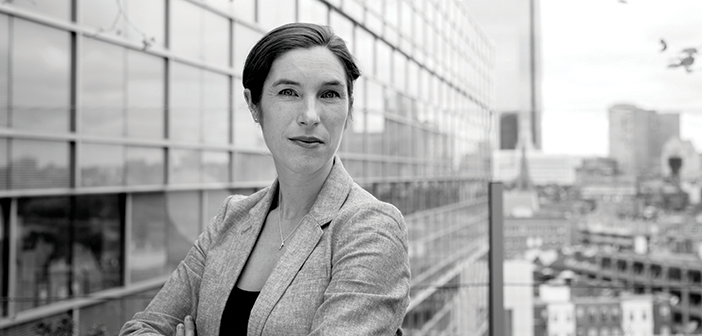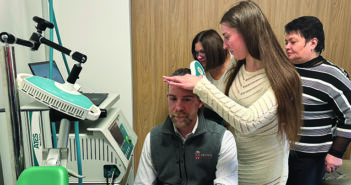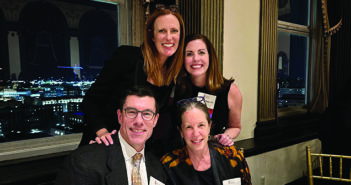Sarah Wakeman ’05 MD’09, an addiction medicine specialist at Massachusetts General Hospital, is describing one of her patients. He was a young man who’d had an almost fatal overdose, probably incurring some brain injury as a result. After a long hospital stay, he was trying to get into treatment, a process that required him to call a program to make an appointment and then remember when the appointment was and then show up at the right time and sit through a therapy session—all before getting the medication he needed to treat his addiction.
“If I could do those things, I probably wouldn’t need treatment,” Wakeman recalls the man saying. “But I’m shooting heroin three times a day. How am I supposed to be able to go through all those steps to actually get the care I need?”
For people who suffer from addiction, the obstacles to care are nothing to sneeze at: it can be tough to find a program in the first place, let alone distinguish good ones from bad, and there’s often a waiting list. Some programs require daily calls or visits as proof of motivation and have other rules that can confound a person who’s using.
Prescription drugs and heroin, on the other hand, are available 24/7—no insurance hurdles, no wait time.
“We make it really, really hard for people to get well, while it’s easy to stay sick,” Wakeman says. “How do we make engaging in treatment and recovery the easy choice rather than the hard choice?”
A Disease by Any Other Name
One of the most formidable barriers is stigma—the widespread belief that addiction is a behavior to punish rather than a disease to treat. “By the time people [with a substance use disorder, or SUD]end up in the medical system, they’ve received the message over many years that they have done something bad, that they’ve failed, that they’re not going to get better,” Wakeman says. “They’ve often been through cycles of ineffective interventions and take that as a sign that they’re a hopeless case.”
Such attitudes come from family, friends, clergy members, the media. But many health care providers have them too, however unconsciously, she says. “When someone with another illness like diabetes or cancer is not getting well, we talk about switching to a different type of medication or intervention, not about the patient trying harder. When it comes to SUDs, we in the medical system need to take responsibility for finding the right treatment rather than blaming the patient.”
Wakeman, whose gaze manages to convey both a laser-like focus and a preternatural calm and whose resting face is a smile waiting to happen, speaks often to fellow physicians about bias and stigma and how to be aware of them. She asks them to imagine telling a diabetic she has to “hit bottom” before she can have her insulin. Or telling a cancer patient he has to drive to a clinic 150 miles away to get his daily dose of chemotherapy. Or telling a patient with heart disease to use her will to heal her heart. Or handing someone who’s had a heart attack a list of cardiologists and wishing them good luck. “They often say, ‘I’ve never thought of that before—that would be malpractice!’” she says. “And yet that’s how we routinely treat people who come into the hospital with some sort of complication related to addiction.”
Then there’s the stigma surrounding the use of the prescription drugs buprenorphine and methadone to treat opioid use disorder—the gold standard, backed by decades of research demonstrating their effectiveness. But because individuals who engage in this therapy are using a daily medication, many people—especially those in the abstinence-only camp—don’t consider them in recovery. Former Secretary of Health and Human Services Tom Price, MD, echoed that belief in 2017 when he equated medication-assisted treatment, or MAT, with “substituting one opioid for another.”
Culture Shift
Like many medical students in the early 2000s, Wakeman was interested in global health and infectious diseases, particularly HIV. But that changed during the summer between her first and second year, when she did an internship with Professor of Medicine Josiah Rich, MD, MPH, in the Rhode Island Department of Corrections, working with inmates who had HIV and hepatitis C—and substance use disorders. It was in prison, where the failures of public policy, public health, and social justice collide, that Wakeman began to think local. “Seeing the tremendous disparities here in our own backyard, I realized we have a lot of work to do at home,” she says.
Still, it wasn’t until 2010, during her internal medicine residency at MGH, that she zeroed in on the relatively new field of addiction medicine. (The American Board of Medical Specialties did not recognize addiction medicine as a subspecialty until 2016.) Mark Eisenberg, MD, a primary care doc at MGH specializing in both HIV and opioid use, recalls that at the time “there was a huge interest in international HIV work and following in Paul Farmer’s footsteps, and very little interest in this other vulnerable population, people with substance use disorder. So when I read [Sarah’s] application and the work she had done as a med student in the prison system, I spent the next three months trying to convince her to come to MGH. I recruited her like I’ve never, ever recruited an applicant before.” In terms of patient population, Wakeman had found her people. “Whenever someone was admitted with a severe substance use disorder, the residents would say, ‘Who wants to take this patient?’ and Sarah’s hand would go up immediately,” Eisenberg says. “She took the most difficult, challenging patients, and she embraced them.”
Located near the Charles River in Boston, MGH treats almost 50,000 inpatients and receives 1.5 million outpatient and more than 108,000 emergency room visits a year. The mission of this health care colossus, in addition to teaching, research, and care, is “to improve the health and well-being of the diverse communities we serve”—namely, Chelsea, Revere, and Charlestown. So in 2012, when the hospital performed health needs assessments in those towns, residents were at the table. Asked to name the number-one problem plaguing their communities, 75 percent pointed to substance use. Not housing, not unemployment, not crime. Substance use.
Two years later, with Wakeman barely two years out of residency, MGH launched its Substance Use Disorders Initiative and asked her to take the lead. According to Eisenberg, at first “there was some skepticism among senior people in psychiatry and addiction saying, ‘She’s too young to have this responsibility. Could this person just coming out of training take on this role?’ It’s Sarah’s energy, personality, and passion that made this happen.” Clearly, the hospital’s leadership saw in Wakeman the same qualities that had impressed Rich when she was a medical student: “Sarah was the kind of person everyone wants to be with, to work with, listen to, to follow. She’s a natural leader and an inspiration.”
Wakeman wasted no time revolutionizing the way the hospital would deal with the opioid epidemic, including making treatment more accessible and the medical workforce more informed about the disease of addiction. In addition to writing hospital guidelines for opioid therapy and contributing to MGH’s strategic plan for SUDs, she helped create a multidisciplinary Inpatient Addiction Consult Team that can evaluate a patient with an SUD and provide both treatment recommendations and connections to community resources. She helped design a recovery coach program, hiring individuals with managed addiction to support and connect with patients. She helped create the Bridge Clinic, a low-threshold site offering walk-in treatment (as well as art classes, yoga, snacks, and hugs) that eases the transition from the hospital back to the community. She helped created the HOPE Clinic, which provides care for pregnant and parenting women and their families. She helped train emergency physicians to start patients who wished to on MAT, creating the first ED-initiated buprenorphine program in Massachusetts. And she created and directs a fellowship in addiction medicine, which welcomed its first three fellows this year.
A collaborative effort among medicine, psychiatry, social work, nursing, and people who provide care to the homeless, the Substance Use Disorders Initiative aims to integrate addiction medicine into and throughout the hospital. The dual goal is to improve patient outcomes and reduce health care costs—what Wakeman calls “doing the right thing and doing the smart thing.” To measure the SUDI’s effectiveness—and to create the evidence base she says is vital to changing attitudes, practices, and policies—she has evaluated each and every program she’s initiated, and the results are in: they’re working.
“We’ve found that patients who were seen by the consult team are able to stay sober for more days out of the month after they’re discharged, they have lower addiction severity, and they’re using the emergency room less,” Wakeman says. “Patients who get their primary care in a practice that has integrated addiction services, including access to medication treatment, also use the emergency department less and engage more in primary care, as do patients who connect with our recovery coaches. And we found that if doctors have interacted with our services, they have less-stigmatizing attitudes about addiction, they feel more prepared to take care of patients, and they’re more likely to offer a treatment themselves.” Wakeman recently received the Nathaniel Bowditch Award from MGH’s board of trustees for improving quality of care while reducing costs.
Watch Your Language
We still have a long way to go before science overcomes stereotypes, or simply habits of mind, Wakeman says. A published poet, she places enormous importance on words. That means replacing stigma-laden words like “addict,” “substance abuser,” and “alcoholism” with “person with addiction” and “alcohol use disorder.” (After all, she points out, we don’t refer to a person with diabetes as a “sugar abuser.”) It means knowing the difference between dependence and addiction. (Contrary to some panicky headlines, babies can be born dependent on opioids, but not addicted to them: dependence is a physiological condition, whereas addiction entails repeated use of a substance despite the harm it causes.) In a 2016 paper in Alcoholism Treatment Quarterly, Wakeman and co-authors explain that attention to words is not about political correctness, it’s about dismantling biases that negatively influence care. Being careful about how we talk about SUD-related matters can actually make for “precise and unambiguous clinical and scientific communication,” opening the way for policies that are based on evidence, not belief or ideology.
In addition to publishing papers and book chapters and speaking to medical professionals across the country, Wakeman cochairs the opioid task force of the MGH Physicians Organization and that of the Partners HealthCare network, and serves on Massachusetts Governor Charlie Baker’s Opioid Addiction Working Group. But she communicates with the general public as well. She tweets about addiction, stigma, and treatment on Twitter (@DrSarahWakeman), where she has more than 6,500 followers. (Her Twitter background says “The good thing about science is that it’s true whether or not you believe in it.”) She is quoted often in mainstream media outlets, from Self and TIME magazines to Vice and Vox.com, and works with and publicly applauds the journalists whose reporting on SUDs she finds accurate and responsible.
Yes, You Can
In Wakeman’s small, tidy office at MGH, there’s a framed print that looks, at first glance, like the Barack Obama poster by Shepard Fairey. Only it’s her upturned face, staring into some brighter future, and instead of “Hope” the text reads “Ask me about dope.” The gift from residents to their chief was part of an end-of-year spoof, but the combined message of dope and hope, while clever, is no joke. Wakeman believes passionately that in addition to proper medical treatment, one of the most important things providers can give people struggling with addiction is hope. “[Our patients] have often been told by everyone in their life that there’s something wrong with them and they’re never going to get better, and they internalize that,” she says. “The most helpful thing we can offer, in addition to the science, is a message of hope and self-efficacy: ‘This is a treatable condition. We can help you.’”
According to Wakeman, changing the narrative also means surfacing the stories of people who are successfully managing their addiction—which can be challenging, since people don’t often advertise they’re in recovery. Although there are 24 million people in recovery in the US, doctors themselves seldom see the ones who go on to do well. “For folks who work in the ED, there’s a sense that no one ever gets better. There’s this revolving door, people coming back again and again. That, I think, worsens the sense of powerlessness and pessimism,” she says. The more doctors see treatment working, the more likely they’ll be to engage.
Those success stories, Eisenberg says, are “sustaining”: they’re what keep people in addiction medicine going. Wakeman describes a patient her age whom she met six years ago. She had a history of trauma, started using heroin early, and developed multiple medical complications. She had never been told that addiction was an illness, much less a treatable one. “When we first met, she was hopeless. I think she truly thought she was going to die as someone with active addiction,” Wakeman says. “Being able to partner with her and share that message of hope and start her on effective treatment was transformative. She’s now five years in recovery. She works full time, she just had her first baby, she’s married, she owns a house.”
It’s a story that neatly embodies Wakeman’s working credo: “We try to meet people where they are, but not leave them where we found them.”




